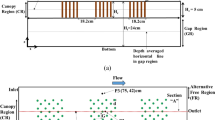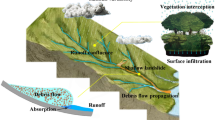Abstract
The floating-vegetation island (FVI) is widely used in river restoration projects for its decontamination effect for the pollutants. A physical experiment is conducted in this paper to study the flow regime near the FVI to better understand the role played by the FVI in the river systems. According to the observed data concerning the mean and turbulent flow characteristics, the flow field can be subdivided into four regions: the incoming flow adjustment region, the initial adjustment region, the shear layer developing region and the fully developed region. The variation of the velocity profile can be described as follows: a “J” shape in the incoming flow adjustment region evolves to an “S” shape in the shear layer developing and fully developed regions. The velocity in the interface between the canopy and the flow in the fully developed region obeys the rule of a mixing layer theory. Based on the experiment data, a three-layer model for estimating the vertical velocity distribution in the fully developed region is established and it performs well as compared with the laboratory findings.
Similar content being viewed by others
References
Nahlik A. M., Mitsch W. J. Tropical treatment wetlands dominated by free-floating macrophytes for water quality improvement in Costa Rica [J]. Ecological Engineering, 2006, 28(3): 246–257.
Downing-Kunz M., Stacey M. Flow-induced forces on free-floating macrophytes [J]. Hydrobiologia, 2011, 671(1): 121–135.
Nichols P., Lucke T., Drapper D. et al. Performance evaluation of a floating treatment wetland in an urban catchment [J]. Water, 2016, 8(6): 244.
Keddy P. A. Wetland ecology: Principles and conservation [M]. Cambridge, UK: Cambridge University Press, 2010.
Stewart F. M., Muholland T., Cunningham A. B. et al. Floating islands as an alternative to constructed wetlands for treatment of excess nutrients from agricultural and municipal wastes-results of laboratory-scale tests [J]. Land Contamination and Reclamation, 2008, 16(1): 25–33.
Borne K. E. Floating treatment wetland influences on the fate and removal performance of phosphorus in stormwater retention ponds [J]. Ecological Engineering, 2014, 69: 76–82.
Nikora V. Hydrodynamics of aquatic ecosystems: An interface between ecology, biomechanics and environmental fluid mechanics [J]. River Research and Applications, 2010, 26(4): 367–384.
Tanner C. C., Sukias J., Park J. et al. Floating treatment wetlands: A new tool for nutrient management in lakes and waterways [J]. Methods, 2011, 2008(2011): 1–13.
Lin Y. F., Jing S. R., Wang T. W. et al. Effects of macrophytes and external carbon sources on nitrate removal from groundwater in constructed wetlands [J]. Environmental Pollution, 2002, 119(3): 413–420.
Toft J. D., Simenstad C. A., Cordell J. R. et al. The effects of introduced water hyacinth on habitat structure, invertebrate assemblages, and fish diets [J]. Estuaries, 2003, 26(3): 746–758.
Zong L., Nepf H. Vortex development behind a finite porous obstruction in a channel [J]. Journal of Fluid Mechanics, 2012, 691: 368–391.
Chen Z., Ortiz A., Zong L. et al. The wake structure behind a porous obstruction and its implications for deposition near a finite patch of emergent vegetation [J]. Water Resources Research, 2012, 48(9): 1–12.
Ozan A. Y. Flow structure at the downstream of a oneline riparian emergent tree along the floodplain edge in a compound open-channel flow [J]. Journal of Hydrodynamics, 2018, 30(3): 470–480.
Ghisalberti M., Nepf H. M. Mixing layers and coherent structures in vegetated aquatic flows [J]. Journal of Geophysical Research: Oceans, 2002, 107(C2): 3xxx1–3xxx11.
Zhang Y., Tang C., Nepf H. Turbulent kinetic energy in submerged model canopies under oscillatory flow [J]. Water Resources Research, 2018, 54(3): 1734–1750.
Wang W J., Peng W. Q., Huai W. X. et al. Roughness height of submerged vegetation in flow based on spatial structure [J]. Journal of Hydrodynamics, 2018, 30(4): 754–757.
Kundu P., Cohen I. Fluid mechanics [M]. 4 th Edition, San Diego, CA, USA: Academic Press, 2008.
Ho C. M., Huerre P. Perturbed free shear layers [J]. Annual Review of Fluid Mechanics, 1984, 16(1): 365–422.
Zhou Q., Jiang C., Liu J. et al. Experimental study of hydraulic jump characteristics in dividing flow of urban streets [C]. 37th IAHR World Congress, Kuala Lumpur, Malaysia, 2017.
Fujita I., Muste M., Kruger A. Large-scale particle image velocimetry for flow analysis in hydraulic engineering applications [J]. Journal of Hydraulic Research, 1998, 36(3): 397–414.
Meinhart C. D., Prasad A. K., Adrian R. J. A parallel digital processor system for particle image velocimetry [J]. Measurement Science and Technology, 1993, 4(5): 619–626.
Rominger J. T., Nepf H. M. Flow adjustment and interior flow associated with a rectangular porous obstruction [J]. Journal of Fluid Mechanics, 2011, 680: 636–659.
Huai W., Li C. G. Longitudinal dispersion in open channel flow with suspended canopies [J]. Water Science and Technology, 2016, 74(3): 722–728.
Zhao F., Huai W., Li D. Numerical modeling of open channel flow with suspended canopy [J]. Advances in Water Resources, 2017, 105: 132–143.
Author information
Authors and Affiliations
Corresponding author
Additional information
Project supported by the National Natural Science Foundation of China (Grant No. 51679121).
Biography: Wang-yang Yu (1987-), Male, Ph. D.
Rights and permissions
About this article
Cite this article
Yu, Wy., Jiang, Cb., Shi, Y. et al. Experimental study of the impact of the floating-vegetation island on mean and turbulence structure. J Hydrodyn 31, 922–930 (2019). https://doi.org/10.1007/s42241-018-0167-6
Received:
Revised:
Accepted:
Published:
Issue Date:
DOI: https://doi.org/10.1007/s42241-018-0167-6




